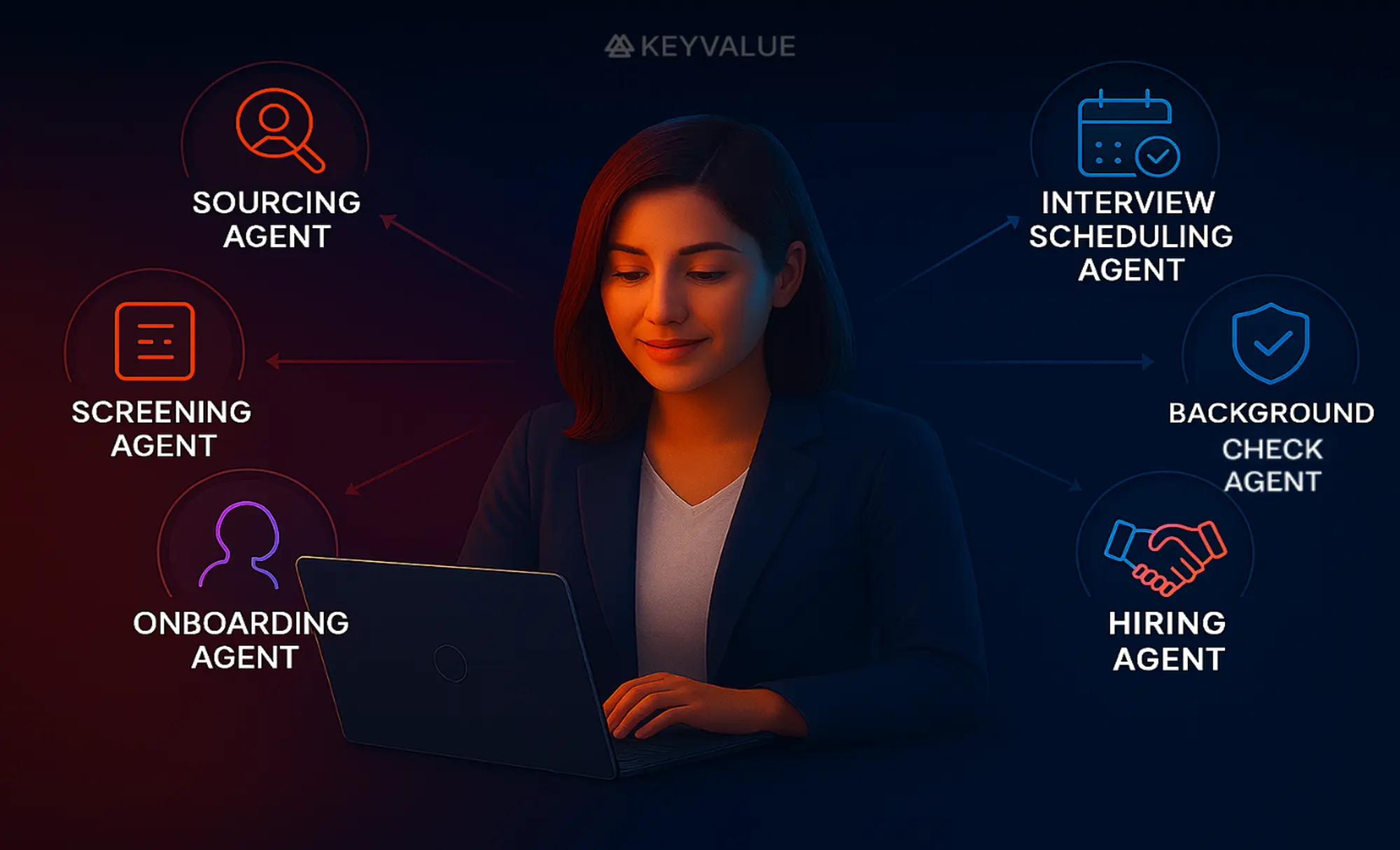
Highlights
- Google’s A2A protocol established a universal language for AI agents to communicate and collaborate for tasks across various tools and systems.
- A2A helps HR teams in employee onboarding automation, empowering AI agents to orchestrate tasks from screening to onboarding.
- Results show 47% faster hiring, with onboarding time cut from two weeks to three days.
It’s hiring season—and no, it’s not a great morning for HR. Resumes are pouring in. Spreadsheets are multiplying. Interviews are lined up. Feedback is slow. And when HR finally gets the green light to roll out an offer, the candidate has already accepted another one.
Now it’s back to square one. They have to start the whole juggle again!
Every HR professional dreams of a system where recruiting, onboarding, and admin tasks flow smoothly, without constant human follow-up. So, who can help with employee onboarding automation? AI agents can, but it’s been limited to automating isolated tasks. Google resolved this challenge by launching the A2A (Agent2Agent) protocol in April 2025. It enables AI agents to work together across the hiring journey, so tasks aren’t just automated; they’re orchestrated.
Let’s take a look at how A2A can give HR teams the employee onboarding process flow they’ve always wanted.
What is Google’s Agent2Agent protocol?
A2A, by Google, established a standard protocol for AI agents to work together, facilitating communication, data exchange, task distribution, and decision making. With this open protocol, the agents’ developer or framework is no longer a barrier for collaborating with each other.
“A2A focuses on enabling agents to collaborate in their natural, unstructured modalities, even when they don’t share memory, tools, and context. We are enabling true multi-agent scenarios without limiting an agent to a “tool".” - Google
A2A is built on popular web standards like HTTP, JSON-RPC, and SSE, for easy integration with existing IT infrastructure. AI agent interoperability results in a significant increase in autonomy, productivity, and cost reduction.
Why is A2A essential for AI agents?
AI agents are programmed to handle discrete tasks. For instance, a skill-matching agent can cross-reference thousands of candidate profiles and choose the profiles that best align with the required skills. But the interview-coordination agent can’t schedule interviews unless the skill-matching agent shares the required details. Yes, collaboration is the challenge for employee onboarding!
AI agents work in silos. As these agents are built on different frameworks by different developers, they don’t speak the same language. They can’t share data across workflows, allocate work to different agents, or negotiate and track tasks.
So, for effective utilization of AI agents, it’s critical to establish a multi-agent system with the Google A2A agent protocol, where seamless collaboration happens.
Employee onboarding without A2A: The struggle is real!
From screening resumes to onboarding employees, HRs struggle with time-consuming manual tasks and fragmented communication. They must draft multiple emails, make countless calls/messages, and update candidate data across numerous systems.
Onboarding coordinators must manually create an employee onboarding checklist. Background verification requires tracking document submissions, cross-checking details manually or hiring a third-party, and tracking progress via email or offline updates. Many more steps ahead, it's a maze of back-and-forth communication.
With multiple departments involved, the onboarding process becomes fragmented, leading to scattered spreadsheets across different systems, multiple follow-ups, and delays. Emails can go unanswered, and details can go missing! Even if different departments use AI agents to automate their tasks, data coordination is a hurdle.
This fragmented workflow:
- Consumes valuable administrative time
- Increases the likelihood of human errors
- Delays integration of new team members
- Creates inconsistent employee experiences
HRs are so used to losing promising candidates due to this bottleneck! It’s time for a change.
Google comments:
“Hiring a software engineer can be significantly simplified with A2A collaboration. Within a unified interface like Agentspace, a user (e.g., a hiring manager) can task their agent to find candidates matching a job listing, location, and skill set. The agent then interacts with other specialized agents to source potential candidates. The user receives these suggestions and can then direct their agent to schedule further interviews, streamlining the candidate sourcing process. After the interview process completes, another agent can be engaged to facilitate background checks.”
A real-world example of candidate sourcing. Source: Google
Benefits of implementing A2A protocol for automating employee onboarding
Let's see how A2A reduces the workload of HRs by helping in employee onboarding automation.
- Automates recruitment & onboarding: From screening candidate profiles to scheduling interviews and coordinating onboarding processes, AI agents, with the help of A2A, can automate complex, time-consuming processes.
“We designed A2A to be flexible and support scenarios where it excels at completing everything from quick tasks to deep research that may take hours and or even days when humans are in the loop.” - Google
- Cross-departmental coordination in real time: Implementing agent-to-agent communication in employee onboarding makes the coordination of different HR systems and AI tools a breeze. No more miscommunications, errors, or delays.
- Secure communication: The A2A protocol helps establish encrypted communication channels to ensure the security and confidentiality of candidate information. It prevents the risk of any unauthorized access.
- Scope for continuous optimization: Multi-agent systems can help establish a real-time feedback mechanism. Different AI agents handling each section can route employee feedback and queries to the concerned team in real time. This helps in the quick resolution of their concerns and the improvement of the onboarding process.
- Better employee engagement and experience: A2A streamlined onboarding helps deliver personalized onboarding experiences, reducing the initial stress and uncertainty faced by new employees. This helps them to quickly integrate into the company culture. Employee experience matters for employee retention.
Xuan Ji from BytePlus cites a real-world case study of a Fortune 500 tech company with over 50,000 employees. After implementing the A2A protocol for employee onboarding automation, the results showed that there was a significant improvement in HR operational efficiency.
- Recruiting efficiency increased by 47%
- Onboarding time decreased from two weeks to three days
- Delay in employee query resolution reduced by 62%
- Yearly HR operational costs dropped by approximately 35%
An employee onboarding workflow powered by A2A!
Let’s imagine a hypothetical scenario: an automated employee onboarding with A2A;
- The Hiring Agent updates the Onboarding Agent once a candidate accepts the offer.
- The Onboarding Agent initiates the onboarding process, gathers documents, and notifies the Background Check Agent.
- The Background Check Agent verifies the details of the new hire.
- The Hiring Agent shares details including joining date, role, manager info, etc.
- The Onboarding Agent triggers onboarding emails, induction coordination, and welcome kit prep.
- On the day of joining, the IT Agent issues an email ID, credentials, and access rights for the new joiner.
- The Administration Agent allocates a laptop and peripherals, workspace, and issues an ID card.
- The Payroll Agent enrolls the employee into the salary and benefits system.
On the day of onboarding, no last-minute rush, no paperwork hassles, no delays—everything runs smoothly!
A2A for seamless employee onboarding: A promising solution
It’s not about AI taking up HR professionals’ jobs but establishing a collaborative relationship where AI agents and HRs can co-work for better onboarding efficiency.
Scalable onboarding solutions with A2A allow HR teams to simply scroll through the dashboard and monitor each step completed by AI agents. A resource-intensive and time-consuming process that consumes days of HRs can be handled by AI agents in seconds.
It’s time for HRs to hire a new employee…Google’s A2A!
At KeyValue, we don’t just follow emerging AI standards; we build with them. A2A is redefining how we craft AI-first products, by synchronizing intelligent agents to execute complex workflows with precision and speed.
FAQs
- What is Google’s A2A protocol?
A2A is an open protocol by Google that allows AI agents to communicate and collaborate across systems to complete tasks together.
- Do A2A supports AI agents built by different vendors?
Yes. A2A is designed to let agents collaborate naturally, even if they don't share the same memory, tools, or context.
- Why does HR need A2A?
It connects siloed AI tools, enabling smooth workflows from hiring to onboarding without manual handoffs.
- What are the main benefits of A2A in HR?
Better cross-departmental coordination, faster hiring, quicker onboarding, fewer errors, better employee experience, and lower HR costs.
- How does A2A improve onboarding?
It automates resume screening, interview scheduling, document verification, IT setup, payroll enrollment, and more—saving time and reducing errors.
- Will A2A replace HR jobs?
No. It supports HR teams by automating routine work, not replacing decision-making or human interaction.
- Is A2A secure for handling sensitive data?
Yes. A2A supports enterprise-level authentication and authorization, matching the standards of OpenAPI’s authentication schemes.
- Can A2A integrate with existing HR tools?
It uses open web standards like HTTP, JSON-RPC, and SSE—easy to integrate with current systems.

